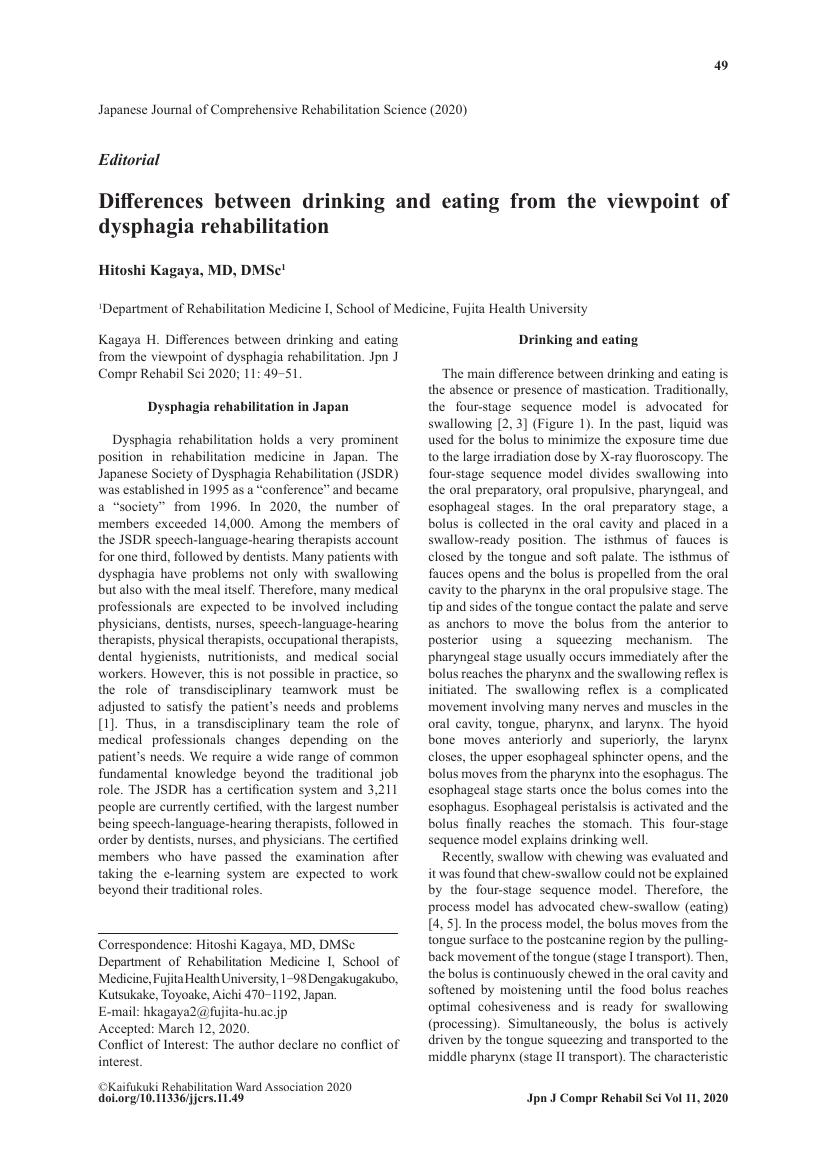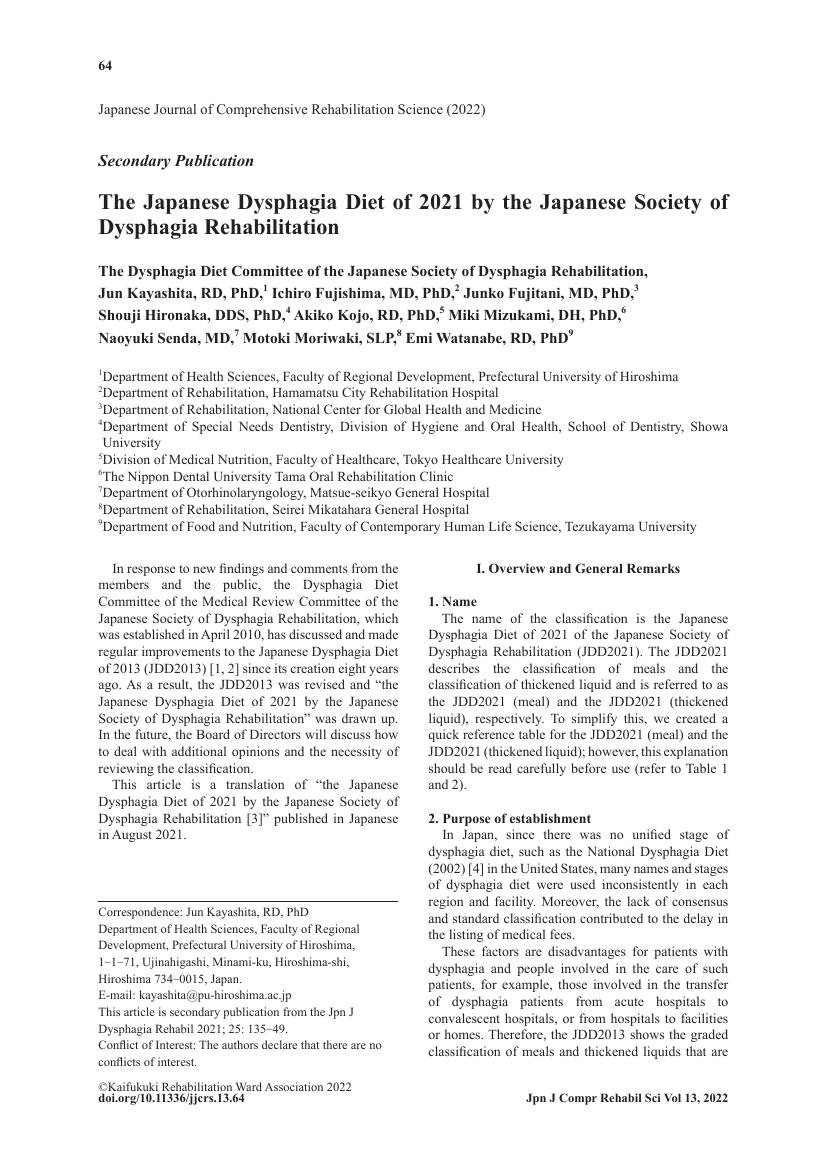- 著者
- Sayako Shimizu Kozo Hanayama Hiromichi Metani Takefumi Sugiyama Hiromasa Abe Sosuke Seki Takashi Hiraoka Akio Tsubahara
- 出版者
- 一般社団法人 回復期リハビリテーション病棟協会
- 雑誌
- Japanese Journal of Comprehensive Rehabilitation Science (ISSN:21855323)
- 巻号頁・発行日
- vol.7, pp.55-60, 2016 (Released:2016-09-09)
- 参考文献数
- 34
- 被引用文献数
- 24
Shimizu S, Hanayama K, Metani H, Sugiyama T, Abe H, Seki S, Hiraoka T, Tsubahara A. Retest reliability of ultrasonic geniohyoid muscle measurement. Jpn J Compr Rehabil Sci 2016; 7: 55-60.Objective: Ultrasonography can be used to assess both the morphology and movement of the muscles of deglutition. This study investigated the intratester, intertester, and retest reliability of ultrasonic assessments of the suprahyoid muscle group.Methods: Three testers performed ultrasonographic measurements of the length and area of the geniohyoid muscle in 10 healthy adults, and the contraction ratio during swallowing. Results were compared using intraclass correlation coefficients (ICCs) to determine intratester, retest, and intertester reliabilities.Results: Intratester and retest reliabilities were very good, with ICCs ≥0.8 for all assessment parameters. In intertester reliability, ICCs were ≥0.8 for geniohyoid muscle length and area during swallowing and ≥0.6 for geniohyoid muscle length at rest and contraction ratio.Discussion: These results indicate high reliability of this assessment method for assessments made by the same individual, with reliability of the method remaining high for assessments performed at intervals.
- 著者
- Makoto Tokunaga Ayumi Beppu Yasuki Tamura Kumiko Oowaki Yoshimi Tokunaga Chika Ishihara Kiyomi Shibata Kiyomi Tanaka Masako Takayama
- 出版者
- 一般社団法人 回復期リハビリテーション病棟協会
- 雑誌
- Japanese Journal of Comprehensive Rehabilitation Science (ISSN:21855323)
- 巻号頁・発行日
- vol.7, pp.7-12, 2016 (Released:2016-05-13)
- 参考文献数
- 13
- 被引用文献数
- 1
Tokunaga M, Beppu A, Tamura Y, Oowaki K, Tokunaga Y, Ishihara C, Shibata K, Tanaka K, Takayama M. Relationship between improvement in GNRI, a nutritional index, and improvement in motor FIM in elderly stroke patients hospitalized in a Kaifukuki Rehabilitation Ward. Jpn J Compr Rehabil Sci 2016; 7: 7-12.Objective: To clarify the relationship between improvement in the Geriatric Nutritional Risk Index (GNRI) and improvement in the Functional Independence Measure (FIM).Methods: The subjects were 155 patients aged 65 years or older selected among stroke patients admitted to a Kaifukuki Rehabilitation Ward. Seven items, including GNRI at hospital admission and degree of GNRI improvement, served as independent variables. For multiple regression analysis, motor FIM score at hospital discharge was the dependent variable. For multiple logistic regression analysis, motor FIM gain (1:13 points or more, 0:12 points or less) was the dependent variable.Results: GNRI at admission was a significant positive independent variable in the multiple regression analysis. GNRI at admission and degree of GNRI improvement were both significant independent variables in the multiple logistic regression analysis, with odds ratios of 1.084 and 1.090, respectively.Conclusion: Improvements in motor FIM are greater when GNRI at admission and the degree of GNRI improvement are larger.
- 著者
- Minoru Murayama
- 出版者
- Kaifukuki Rehabilitation Ward Association
- 雑誌
- Japanese Journal of Comprehensive Rehabilitation Science (ISSN:21855323)
- 巻号頁・発行日
- vol.12, pp.32-37, 2021 (Released:2021-09-03)
- 参考文献数
- 7
- 被引用文献数
- 1
Murayama M. Effectiveness of a knee-ankle-foot orthosis with a knee extension aid in gait training for stroke patients. Jpn J Compr Rehabil Sci 2021; 12: 32-37.Objective: To evaluate the effectiveness of a kneeankle- foot orthosis (KAFO) with a newly developed knee extension aid in gait training for stroke patients with severe leg paralysis.Methods: The participants were 7 recovering stroke patients prescribed a KAFO. With the KAFO knee joint set to allow free flexion, knee flexion angle, lower limb muscle activity, and time of plantar ground contact were measured during assisted walking with the knee extension aid or a conventional support loop.Results: When first using the knee extension aid, knee flexion angle at initial ground contact was significantly decreased and time from heel strike on the paralyzed side to forefoot strike was prolonged compared with the support loop. After using the knee extension aid for 1 week, in addition to the two parameters above, maximum knee flexion angle during the swing phase, knee extension displacement from the maximum flexion angle to initial ground contact, and the muscle activity ratio of the biceps femoris during the swing phase were significantly increased compared with the support loop.Conclusion: This knee extension aid may be indicated for patients who have difficulty in initial heel strike due to excessive knee flexion at the end of the swing phase.
2 0 0 0 OA Activities of daily living and quality of life assessment during home-based rehabilitation
- 著者
- Kazunori Kojima Taku Nakayama Asami Watanabe Shiro Yoshimura Tomonori Yamaya Konomi Sato Ari Doi Takako Ogino Noriko Moriyasu Susumu Watanabe
- 出版者
- 一般社団法人 回復期リハビリテーション病棟協会
- 雑誌
- Japanese Journal of Comprehensive Rehabilitation Science (ISSN:21855323)
- 巻号頁・発行日
- vol.8, pp.30-36, 2017 (Released:2017-04-29)
- 参考文献数
- 31
- 被引用文献数
- 4
Kojima K, Nakayama T, Watanabe A, Yoshimura S, Yamaya T, Sato K, Doi A, Ogino T, Moriyasu N, Watanabe S. Activities of daily living and quality of life assessment during home-based rehabilitation - A multi-institutional study. Jpn J Compr Rehabil Sci 2017; 8: 30-36.Objective: The purpose of this study was to examine the relationship between activities of daily living (ADL) performance and quality of life (QOL) in participants in a home-based rehabilitation program, and to assess the associated changes during the program.Methods: The subjects were participants newly enrolled in home-based rehabilitation in six facilities. The Functional Independence Measure motor subscore was used to evaluate the current ADL performance. We used PGC-MS to evaluate the emotional aspect of QOL, and ADL satisfaction for the cognitive aspect.Results: Participants were divided into two groups: <1 year from onset and >1 year from onset; ADL satisfaction had significantly improved in the latter group (p = 0.008). A strong correlation between ADL performance and ADL satisfaction was found. On the other hand, the correlation between ADL satisfaction and PGC-MS was weaker.Conclusions: The ‘cognitive aspect’ of QOL improved due to the rehabilitation staff’s approach in explaining the participants’ ADL abilities and motivating them to accept their limitations. It is considered that the ‘emotional aspect’ of QOL is difficult to change with only three months of home-based rehabilitation.
- 著者
- Hiroyuki Miyasaka Wataru Narita Yuuki Nakagawa Rieko Kanamori Maki Ohshita Satsuki Kawakami Koji Shimomura Izumi Kondo Shigeru Sonoda
- 出版者
- 一般社団法人 回復期リハビリテーション病棟協会
- 雑誌
- Japanese Journal of Comprehensive Rehabilitation Science (ISSN:21855323)
- 巻号頁・発行日
- vol.7, pp.61-72, 2016 (Released:2016-09-09)
- 参考文献数
- 30
Miyasaka H, Narita W, Nakagawa Y, Kanamori R, Ohshita M, Kawakami S, Shimomura K, Kondo I, Sonoda S. Development and validity of an evaluation of higher cortical dysfunction in the daily life of patients with stroke and traumatic brain injury. Jpn J Compr Rehabil Sci 2016; 7: 61-72.Purpose: To develop a valid Cognition-oriented Performance Evaluation (COPE) questionnaire for the evaluation of higher brain function in any environment using the nominal group technique (NGT).Method: The NGT participants included nine expert staff members of our hospital. The NGT process was performed twice and involved: 1) enumerating questions regarding the presence or absence of higher cortical dysfunction symptoms, 2) judging each item on a four-point scale and posing additional questions, 3) determining the level of agreement across participants using the NGT, and 4) modifying, removing, and adding questions based on the agreement and comments of the NGT participants. In addition, a correlation analysis between COPE areas and the social cognition items of the Functional Independence Measure (FIM) was performed in 20 patients with higher cortical dysfunction.Results and discussion: An initial 126 questions were crafted prior to the NGT. During the first NGT, 12 items failed to achieve adequate agreement, and during the second NGT, three items failed. Furthermore, we coordinated the expressed opinions after the second NGT. The final version contained 96 items. Correlation analysis demonstrated significant correlation between the COPE and FIM in related items such as memory and problem-solving. Thus, the validity of the COPE was verified using a qualitative research technique (consensus method) and by correlation with another scale.
- 著者
- Hitoshi Kagaya
- 出版者
- Kaifukuki Rehabilitation Ward Association
- 雑誌
- Japanese Journal of Comprehensive Rehabilitation Science (ISSN:21855323)
- 巻号頁・発行日
- vol.11, pp.49-51, 2020 (Released:2020-06-13)
- 参考文献数
- 12
- 被引用文献数
- 2 3
- 著者
- Jun Kayashita Ichiro Fujishima Junko Fujitani Shouji Hironaka Akiko Kojo Miki Mizukami Naoyuki Senda Motoki Moriwaki Emi Watanabe
- 出版者
- Kaifukuki Rehabilitation Ward Association
- 雑誌
- Japanese Journal of Comprehensive Rehabilitation Science (ISSN:21855323)
- 巻号頁・発行日
- vol.13, pp.64-77, 2022 (Released:2023-02-28)
- 参考文献数
- 16
- 被引用文献数
- 13
- 著者
- Takashi Hiraoka
- 出版者
- Kaifukuki Rehabilitation Ward Association
- 雑誌
- Japanese Journal of Comprehensive Rehabilitation Science (ISSN:21855323)
- 巻号頁・発行日
- vol.12, pp.1-3, 2021 (Released:2021-05-07)
- 参考文献数
- 7
- 被引用文献数
- 1 5
- 著者
- Fumihiro Matsuda Masahiko Mukaino Kei Ohtsuka Hiroki Tanikawa Kazuhiro Tsuchiyama Toshio Teranishi Yoshikiyo Kanada Hitoshi Kagaya Eiichi Saitoh
- 出版者
- Kaifukuki Rehabilitation Ward Association
- 雑誌
- Japanese Journal of Comprehensive Rehabilitation Science (ISSN:21855323)
- 巻号頁・発行日
- vol.7, pp.111-118, 2016 (Released:2016-12-30)
- 参考文献数
- 20
- 被引用文献数
- 19
Matsuda F, Mukaino M, Ohtsuka K, Tanikawa H, Tsuchiyama K, Teranishi T, Kanada Y, Kagaya H, Saitoh E. Analysis of strategies used by hemiplegic stroke patients to achieve toe clearance. Jpn J Compr Rehabil Sci 2016; 7: 111-118.Objective: The purpose of this study was to analyze the extent to which lower limb shortening and compensatory movements contribute to toe clearance during swing, and to identify the different strategies employed by healthy individuals and hemiplegic stroke patients to achieve toe clearance.Methods: The subjects comprised 18 hemiplegic stroke patients and 18 healthy individuals matched for age, gender, and walking speed. We calculated toe clearance and its components for comparison between the two groups. We also calculated the correlations between the components.Results: The foot-to-floor distance during mid-swing was smaller in hemiplegic stroke patients than in healthy individuals. Regarding the components, shortening of hip-toe length (SHTL) was smaller in stroke patients, whereas upward movement of the hip due to pelvic obliquity, upward movement of the foot due to abduction, and upward movement of the contralateral hip were all greater. Among hemiplegic stroke patients, there were significant negative correlations between SHTL and the other components.Conclusions: Hemiplegic stroke patients achieved smaller upward movement by lower limb shortening compared with healthy individuals. The contribution of hip hiking and other compensatory movements that correlated to SHTL appeared to be important in achieving toe clearance.


